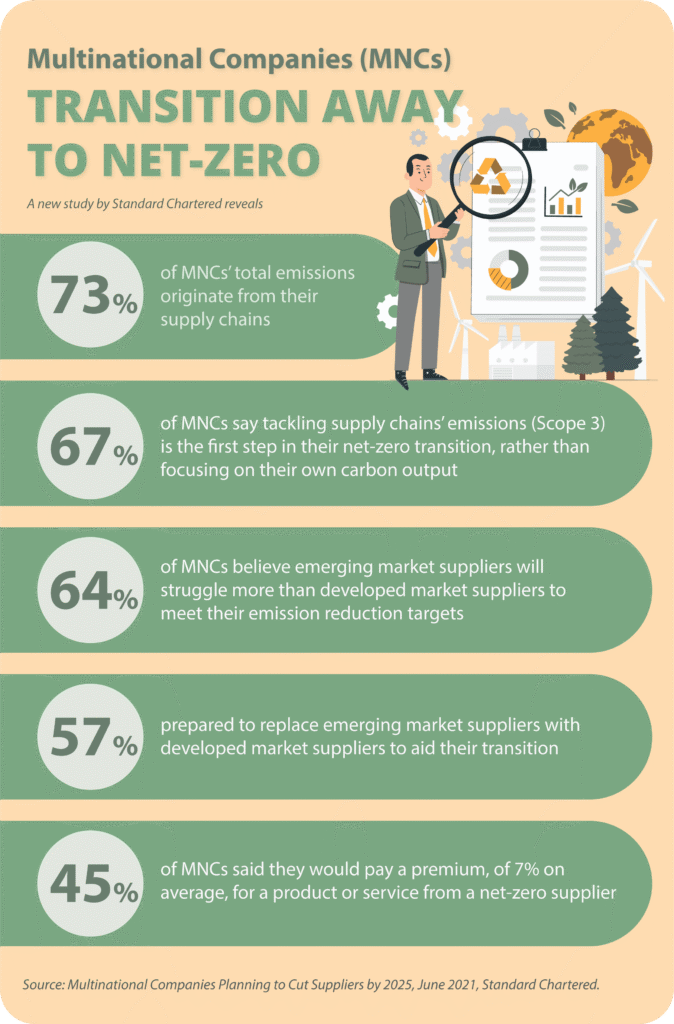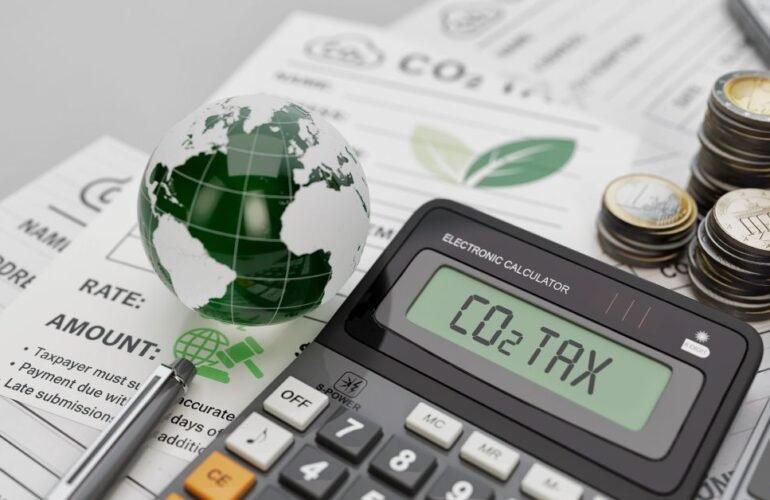For businesses today that are trying to be more environmentally conscious, managing the carbon emissions in their supplier chains can be a significant issue. Indirect or Scope 3 emissions represent a major problem that companies must address. Still, fortunately, AsiaESG’s ESG Solution is on hand to help in developing effective strategies to deal with this crucial aspect of running an organisation.
Why Managing Supply Chain Carbon Emissions Matters
Supply chains create massive amounts of carbon emissions. Research shows that supply chains account for over 60% of global greenhouse gas emissions. For most companies, around 90% of their total emissions happen in their supply chain. This makes supplier carbon management crucial for any serious climate action.
The benefits go beyond helping the environment. Companies with strong carbon management often see better results in several areas. They attract more investors who care about sustainable business practices. Their brand reputation improves with customers who want to buy from responsible companies. They also prepare better for new laws about carbon reporting that governments keep introducing.

Understanding Carbon Emissions in Supply Chains
Suppliers create carbon emissions in many ways. These include their production processes, energy use, storing goods, and transporting products to your business. The emissions add up quickly across complex supply chains that span multiple countries and industries.
Companies must track three types of emissions:
- Scope 1: Direct emissions from company operations
- Scope 2: Indirect emissions from purchased energy
- Scope 3: All other indirect emissions from the supply chain
Scope 3 emissions are often 11.4 times higher than a company’s direct operational emissions. This huge difference shows why supplier engagement becomes so important for meaningful carbon reduction.
The Importance Of Managing Carbon Emissions In Supply Chains
Reducing carbon footprints has never been more crucial, and when it comes to businesses, the importance should never be underestimated. Yet, while companies can implement initiatives to manage their operations in order to cut Scope 1 and 2 emissions that they produce directly or through their owned assets, it’s more challenging to put steps in place to manage Scope 3 emissions that are produced by third parties like suppliers.
Carbon Emission Activities In The Supply Chain
Suppliers may produce carbon emissions in many ways, from their own production processes and energy consumption activities to the storage and transportation of goods, and in their purchasing activities. Yet all businesses now have a corporate responsibility to slash their carbon emissions as much as possible in order to protect our natural environment and reduce the negative impact on climate change.
Of course, managing carbon emissions serves a regulatory purpose, but it can also offer benefits to the organisation. Demonstrating a socially and environmentally aware stance can improve the brand’s reputation and help it to achieve a better market position, while attracting more investors and shareholders who, themselves, value ethical and responsible practices.
Key Strategies for Reducing Supplier Carbon Emissions
Procurement choices can be a powerful lever for climate action, encouraging suppliers to align with sustainability objectives for greater collective impact.
1. Prioritise and Segment Your Suppliers
Not all suppliers need the same approach. Smart companies focus their efforts where they can make the biggest impact. You should segment suppliers based on:
- Emissions contribution: Start with suppliers that create the most carbon emissions
- Spend importance: Focus on key partners where you have strong relationships
- Climate readiness: Consider where suppliers are in their sustainability journey
- Your influence: Assess whether you can actually change supplier behaviour
This targeted approach helps you use resources wisely and gets better results faster.
2. Integrate Climate Goals into Purchasing Decisions
Procurement teams hold real power to drive change. When you include carbon performance in supplier selection, it sends a clear message that sustainability matters. Effective approaches include:
- Adding emissions targets to supplier contracts
- Requiring climate data in tender processes
- Giving preference to low-carbon suppliers
- Setting sustainability requirements for new partnerships
Leading companies like Ford Motor Company now ask strategic suppliers to share data on greenhouse gas emissions and environmental risks.
3. Support Supplier Education and Capability Building
Many suppliers, especially smaller ones, want to reduce emissions but lack the knowledge or resources. Providing support helps build their capability whilst improving your supply chain. Useful support includes:
- Training sessions on measuring and reducing emissions
- Sharing best practices and case studies
- Providing access to carbon accounting tools
- Connecting suppliers with green financing options
This collaborative approach builds trust and enables suppliers to meet your expectations more effectively.
4. Use Technology for Better Tracking and Transparency
Digital tools make carbon management much easier and more accurate. Advanced technologies help in several ways:
- Data analytics to track emissions and identify reduction opportunities
- IoT sensors for real-time monitoring of energy use and emissions
- Artificial intelligence to optimise transport routes and reduce fuel consumption
- Digital platforms to collect and verify supplier carbon data
Companies using these tools report significant improvements in both efficiency and emission reductions.
5. Promote Renewable Energy Adoption
Switching to renewable energy creates one of the biggest opportunities for emission reductions. You can encourage suppliers to:
- Use solar, wind, or other clean energy sources
- Purchase renewable energy certificates
- Invest in on-site renewable energy generation
- Join group purchasing schemes for clean energy
The International Energy Agency reports that switching from fossil fuels to clean energy can significantly cut supply chain emissions.
6. Optimise Transport and Logistics
Transportation creates major emissions in most supply chains. Effective strategies include:
- Route optimisation using smart software to reduce fuel use
- Shipment consolidation to put more goods in fewer vehicles
- Electric vehicles for deliveries where possible
- Alternative transport modes like rail instead of trucks for long distances
Companies like UPS have saved millions of miles and gallons of fuel through route optimisation systems.
7. Embrace Circular Economy Principles
Moving towards a circular economy naturally reduces emissions by design. This approach focuses on:
- Keeping materials in use longer through repair and refurbishment
- Recycling and reusing products at end of life
- Designing out waste from the beginning
- Creating closed-loop systems that minimise resource extraction
Research suggests that circular economy practices could reduce global greenhouse gas emissions by 39%.
8. Set Science-Based Targets and Monitor Progress
Clear targets create accountability and drive real action. Best practices include:
- Setting science-based emissions reduction targets aligned with climate goals
- Requiring suppliers to set their own reduction targets
- Regular monitoring and reporting of progress
- Recognising and rewarding supplier achievements
Companies with science-based targets often see better supplier engagement and faster progress towards emissions reduction goals.
The Role Of ESG Reporting in The Management Of Climate Risks
Governments increasingly use carbon pricing to encourage emission reductions. Singapore leads with a comprehensive carbon tax that started at S$5 per tonne in 2019, rose to S$25 in 2024, and will reach S$45 by 2026. Similar systems operate in South Korea and Japan, creating financial incentives for suppliers to reduce their carbon footprint.
These policies affect supply chain costs and create opportunities for competitive advantage. Companies that help suppliers prepare for carbon pricing often strengthen their partnerships whilst reducing overall supply chain risks.
ESG Reporting and Supply Chain Transparency
Environmental, Social, and Governance (ESG) reporting requirements keep expanding globally. New regulations like the EU’s Corporate Sustainability Reporting Directive will affect over 50,000 companies, requiring detailed disclosure of supply chain emissions.
Effective ESG reporting provides stakeholders with crucial information about how your business manages climate risks. It also helps identify improvement opportunities and demonstrates your commitment to responsible business practices.
Measuring Success and Continuous Improvement
Successful supply chain carbon management requires ongoing measurement and improvement. Key performance indicators should include:
- Total supply chain emissions reduction over time
- Percentage of suppliers with their own emission reduction targets
- Supplier engagement rates in sustainability programmes
- Energy efficiency improvements across the supply chain
- Progress towards renewable energy adoption
Regular monitoring helps identify what works best and where to focus future efforts. It also provides data needed for accurate reporting and stakeholder communication.
Building Resilient, Low-Carbon Supply Chains
The future belongs to companies that build resilient, low-carbon supply chains. This means creating partnerships with suppliers who share your commitment to sustainability. It involves investing in new technologies and processes that reduce emissions whilst improving efficiency.
Smart companies start this journey early, before regulations force change. They work closely with suppliers to identify opportunities and overcome barriers. They use their purchasing power to drive positive change throughout their supply network.
The transition to low-carbon supply chains takes time and effort. However, the benefits include lower costs, reduced risks, improved reputation, and better preparation for a carbon-constrained future. Companies that act now will gain competitive advantages that last for years to come.
Managing carbon emissions in supplier chains represents both a challenge and an opportunity. Businesses that develop effective strategies will reduce their environmental impact whilst building stronger, more sustainable operations. The key lies in taking a systematic approach that engages suppliers as partners in the journey towards a low-carbon future.
When companies invest in reliable climate-related reports and disclosures, they can set themselves on the path towards improved management of carbon emissions in their supply chain. Market participants will also be able to manage and price climate risks more effectively upon reading these ESG reports.
AsiaESG is on hand to assist with all your ESG reporting needs. Our comprehensive reports will provide your stakeholders with key information about the way your organisation manages and addresses all ESG issues, boosting its reputation while also ensuring you mitigate your potential risks and maintain regulatory compliance in the long run.
For any enquiries or quotations pertaining to ESG Solutions, contact our ESG Solutions department below.




